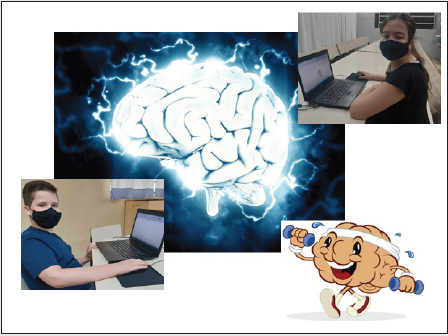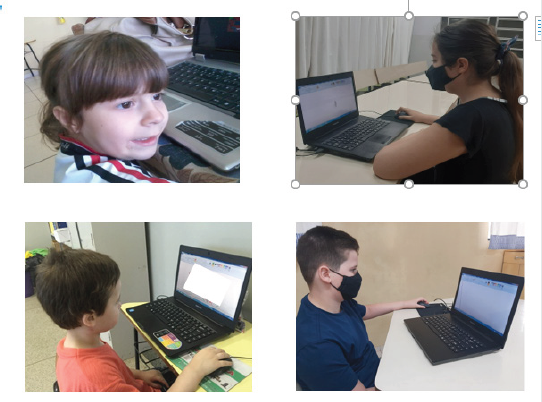
Lupine Publishers Group
Lupine Publishers
Menu
ISSN: 2644-1217
Research ArticleOpen Access
Benefit Of Multimedia Rehabilitation - Academy for The Brain as Intense Brain Stimulation in The Treatment of People with ASD Autism Spectrum Disorder Volume 3 - Issue 4
Branco, Luciana Maria Depieri
Department of Neurological Sciences, Faculty of Medicine of São José do Rio Preto –FAMERP - SP – Brazil
Received: August 30, 2021 Published: September 17, 2021
*Corresponding author: Luciana Maria Depieri,Department of Neurological Sciences, Faculty of Medicine of São José do Rio Preto –FAMERP - SP– Brazil
DOI: 10.32474/OAJCAM.2021.03.000166
Abstract
Autistic Spectrum Disorder (ASD) is a syndrome characterized by problems with socialization, communication, and behavior. This syndrome causes the child to present some specific characteristics most of the time, such as difficulty in communication, speech, difficulty in expressing feelings and ideas, they often feel uncomfortable in the presence of people who do not know them and avoid eye contact, in addition to repetitive patterns and stereotyped movements, such as spending a lot of time rocking your body or an object. However, it is not a rule that everyone has the same repetitive patterns, some children have more than others. We know that our brain can be “reprogrammed” at every moment, creating new synaptic connections and promoting neurogenesis (birth of new neurons, mainly in the hippocampus region). Brain plasticity, or neuroplasticity, is the brain’s ability to recover and restructure. This adaptive capacity of the nervous system allows the brain to recover from disorders or injuries. The Multimedia Rehabilitation technique - Brain Gymnastics - Neurofitness promotes intense brain stimulation, where using the computer it is possible to have all areas of the brain exercised simultaneously. Therefore, this is a technique of great worldwide relevance in the intervention and treatment of people with autism spectrum disorder (ASD), where it is possible to promote great stimulation in all areas of the cerebral cortex simultaneously, bringing neurological maturity in a global way, favoring the developing all areas that occur deficits and awakening new skills and talents.

Introduction
Autism Spectrum Disorder (ASD) brings together neurological
development disorders present from birth or early childhood. They
are: Early Childhood Autism, Childhood Autism, Kanner Autism,
High Functioning Autism, Atypical Autism, Global Developmental
Disorder (PDD) not otherwise specified, Childhood Disintegrative
Disorder and Asperger’s Syndrome. According to the Diagnostic
and Statistical Manual of Mental Disorders DSM-5 (world
reference for diagnostic criteria), people within the spectrum
may have deficits in social communication or social interaction
(such as verbal or non-verbal languages and socio- emotional
reciprocity) and restricted patterns and repetitive behavior,
such as continuous movements, fixed interests, and hypo or
hypersensitivity to sensory stimuli. All patients with autism share
these difficulties, but each will be affected to different degrees,
resulting in very particular situations. Despite still being called
infantile autism, because the diagnosis is common in children and
even babies, disorders are permanent conditions that accompany
the person through all stages of life. Autistic Spectrum Disorder
(ASD) is currently classified into 3 grades: mild autism, moderate
autism, severe autism.
ASD affects the individual’s behavior, and the first signs can be
noticed in babies a few months old. In general, a child on the autistic
spectrum has the following symptoms:
Difficulty interacting socially, such as maintaining eye
contact, facial expression, gestures, expressing one’s emotions and
making friends.
Difficulty in communication, opting for repetitive use of
language and blocks to start and maintain a dialogue.
Behavioral changes, such as manias, excessive attachment
to routines, repetitive actions, intense interest in specific things,
difficulty in imagination and sensory sensitivity (hyper or hypo).
There is still a lot to be unveiled about the brain and ASD, but
research carried out with neuroimaging, such as functional magnetic
resonance imaging (FMRI), show that there is a low functional
connectivity of neurons in ASD, which can trigger changes in tasks
involving the working memory and facial recognition.
Research also indicates that the volume of structures in
the right hemisphere, related to language functions and social
interaction, is greater than in the left hemisphere when comparing
people without and with ASD. Hypoactivation of the left hemisphere
compared to the right hemisphere, abnormal synaptic maturation,
and mirror neuron dysfunction are also cited as possible causes
and pathophysiology of ASD (Amatachaya et al., 2015). Regarding
learning, we can say that currently, with the growing number of
special children enrolled in regular education, there is growing
concern about the learning of these students and how interventions
and adaptations can be made in the curriculum so that they can meet
this diversity of children and participate inclusion in the classroom.
However, many challenges are found in teaching so that there is
an advance in the learning of these children, especially autistic
students, which is the focus of this study. The learning of autistic
students is surrounded by many challenges for parents, teachers
and professionals involved in this process, as they understand that
personalized strategies need to be designed for each child, according
to their reality and experience, in order to value their potential and
enable the acquisition of new knowledge, social integration and
development of new skills. To enhance this learning in a specialized
way, Multimedia Rehabilitation - Brain Gymnastics - Neurofitness
seeks to contribute through interventions in the learning process
in a therapeutic way, to improve the cognitive, linguistic, and social
aspects of children with special needs. Based on this, the question is:
How Multimedia Rehabilitation - Brain Gymnastics - Neurofitness
can contribute to the progress of the student with autism (ASD)?
We know that through neuroplasticity we can “reprogram”
our brain, creating new synaptic connections. Brain plasticity, or
neuroplasticity, is the brain’s ability to recover and restructure.
This adaptive capacity of the nervous system allows the brain to
recover from disturbance or injury. The Multimedia Rehabilitation
technique - Brain Gymnastics promotes intense brain stimulation,
where using the computer it is possible to have all areas of the
brain exercised simultaneously. If in autistic people there are
failures in synaptic connections, through brain stimuli it is possible
to intensely increase neural connections, causing new routes
to be created so that there is neurological development, where
the individual can learn and develop new skills and talents. The
activities are carried out using the conventional mouse, where
programmed activities are directed to everyone, respecting, and
obeying their degree of difficulty, but with each overcoming it is
necessary to launch an even greater challenge, as the brain needs to
be challenged with each instant. We must get him out of his “comfort
zone”, proposing dynamic, challenging, and creative activities. The
results observed in people with ASD who were submitted to the
Multimedia Rehabilitation brain stimulation treatment were of
great relevance, where a total of 10 children and 10 adults with
ASD participated in the consultations. All underwent consultations
during a period of at least one year, noting relevant improvement in
general in neurological development and maturation. They showed
improvement in speech development, where four-year-old children
did not speak at all and after one to two months of treatment
through Multimedia Rehabilitation care, they began to “babble” the
first syllables, it was possible to notice that the brain was being “
unlocked” and thereafter, every week they presented better speech
development. Each week they were able to speak better, getting a
wider, richer vocabulary, thus facilitating their communication.
Relevant improvements in attention, concentration, reasoning,
improvement in observation and performance of the developed
activities were also observed. The level of understanding and
obedience improved a lot in all participants, being possible to
notice significant and relevant advances in behavior, socialization,
communication, and affectivity.
- The examples below are from the application of the Multimedia
Rehabilitation Project – Brain Gymnastics – Neurofitness in Municipal Schools that take place in the municipality of Olímpia
Tourist Resort – SP / Brazil, where it began in the management
of the municipal government in 2010 and due the results of great
relevance remained until the current administration.

Images of children with ASD (Autistic Spectrum Disorder)
followed up with Multimedia Rehabilitation from the age of 3 to
the present time We can see two examples of children with Autism
(ASD) who participate in Multimedia Rehabilitation services from
the age of 3 to the present. They developed autonomy, security,
self-esteem, orality, reasoning, language, socialization, and a lot
of happiness during the activities. We note the pride with which
these children carry out the activities, feeling capable of creating,
transforming, and expressing their skills and talents. Advances
are also perceived by the family in daily activities, where they
report greater security, autonomy, resilience, and new discoveries.
“It is important to emphasize that despite the difficulties faced
by people with ASD, they have a very rich and dynamic brain,
waiting for challenges that make them grow.” It is necessary to
insist, encourage, challenge skills suggesting increasingly complex
activities and especially believe in the capacity that each one has
and be willing to show them how much they are capable of being
better each day.
Live online services in all countries. Access our website www.
reabilitacaomultimidia.com.br

Top Editors
-

Mark E Smith
Bio chemistry
University of Texas Medical Branch, USA -

Lawrence A Presley
Department of Criminal Justice
Liberty University, USA -

Thomas W Miller
Department of Psychiatry
University of Kentucky, USA -

Gjumrakch Aliev
Department of Medicine
Gally International Biomedical Research & Consulting LLC, USA -

Christopher Bryant
Department of Urbanisation and Agricultural
Montreal university, USA -

Robert William Frare
Oral & Maxillofacial Pathology
New York University, USA -

Rudolph Modesto Navari
Gastroenterology and Hepatology
University of Alabama, UK -

Andrew Hague
Department of Medicine
Universities of Bradford, UK -

George Gregory Buttigieg
Maltese College of Obstetrics and Gynaecology, Europe -

Chen-Hsiung Yeh
Oncology
Circulogene Theranostics, England -
.png)
Emilio Bucio-Carrillo
Radiation Chemistry
National University of Mexico, USA -
.jpg)
Casey J Grenier
Analytical Chemistry
Wentworth Institute of Technology, USA -
Hany Atalah
Minimally Invasive Surgery
Mercer University school of Medicine, USA -

Abu-Hussein Muhamad
Pediatric Dentistry
University of Athens , Greece

The annual scholar awards from Lupine Publishers honor a selected number Read More...




